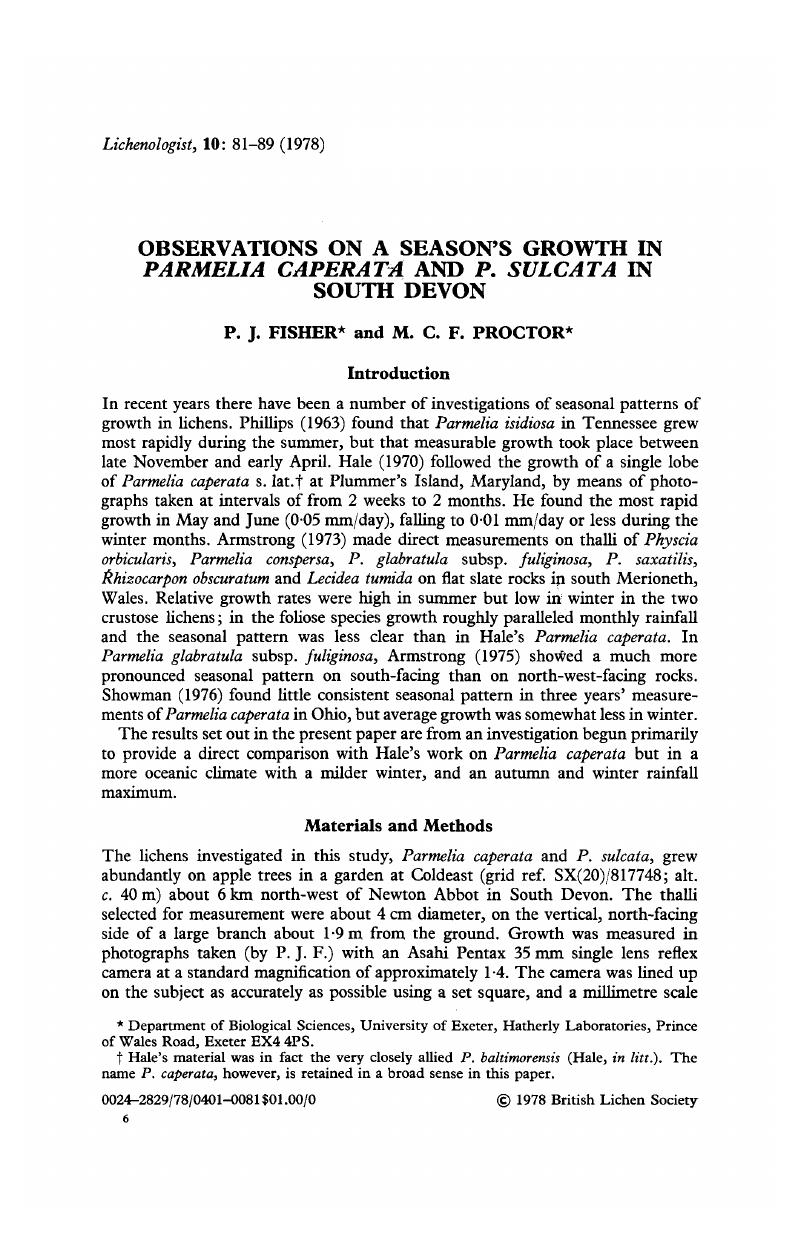Crossref Citations
This article has been cited by the following publications. This list is generated based on data provided by Crossref.
Aplin, P.S.
and
Hill, D.J.
1979.
Growth analysis of circular lichen thalli.
Journal of Theoretical Biology,
Vol. 78,
Issue. 3,
p.
347.
Proctor, M. C. F.
1980.
Estimates from hemispherical photographs of the radiation climates of some bryophyte habitats. in the British Isles.
Journal of Bryology,
Vol. 11,
Issue. 2,
p.
351.
Hawksworth, David L.
and
Hill, David J.
1984.
The Lichen-Forming Fungi.
p.
45.
Hill, D. J.
1985.
Lichen Physiology and Cell Biology.
p.
303.
Fiechter, Elisabeth
and
Honegger, Rosmarie
1987.
Seasonal variations in the fine structure ofHypogymnia physodes (lichenizedAscomycetes) and itsTrebouxia photobiont.
Plant Systematics and Evolution,
Vol. 158,
Issue. 2-4,
p.
249.
Sanders, William
1989.
GROWTH AND DEVELOPMENT OF THE RETICULATE THALLUS IN THE LICHEN RAMALINA MENZIESII.
American Journal of Botany,
Vol. 76,
Issue. 5,
p.
666.
Benedict, James B.
1990.
Experiments on Lichen Growth. I. Seasonal Patterns and Environmental Controls.
Arctic and Alpine Research,
Vol. 22,
Issue. 3,
p.
244.
Armstrong, R.A.
1993.
Seasonal growth of foliose lichens in successive years in South Gwynedd, Wales.
Environmental and Experimental Botany,
Vol. 33,
Issue. 2,
p.
225.
ARMSTRONG, R. A.
1993.
Factors determining lobe growth in foliose lichen thalli.
New Phytologist,
Vol. 124,
Issue. 4,
p.
675.
Sanders, William B.
and
Ascaso, Carmen
1995.
Reiterative production and deformation of cell walls in expanding thallus nets of the lichen ramalina menziesii (Lecanorales, Ascomycetes).
American Journal of Botany,
Vol. 82,
Issue. 11,
p.
1358.
Loppi, Stefano
and
Bargagli, Roberto
1996.
Lichen biomonitoring of trace elements in a geothermal area (central Italy).
Water, Air, and Soil Pollution,
Vol. 88,
Issue. 1-2,
p.
177.
LOPPI, STEFANO
and
DE DOMINICIS, VINCENZO
1996.
Lichens as long-term biomonitors of air quality in central Italy.
Acta Botanica Neerlandica,
Vol. 45,
Issue. 4,
p.
563.
Armstrong, R.A
and
Smith, S.N
1998.
Does radial growth of the lichen Parmelia conspersa depend exclusively on growth processes at the lobe tip?.
Environmental and Experimental Botany,
Vol. 39,
Issue. 3,
p.
263.
Scerbo, R.
Possenti, L.
Lampugnani, L.
Ristori, T.
Barale, R.
and
Barghigiani, C.
1999.
Lichen (Xanthoria parietina)̄ biomonitoring of trace element contamination and air quality assessment in Livorno Province (Tuscany, Italy).
Science of The Total Environment,
Vol. 241,
Issue. 1-3,
p.
91.
Scerbo, R
Ristori, T
Possenti, L
Lampugnani, L
Barale, R
and
Barghigiani, C
2002.
Lichen (Xanthoria parietina) biomonitoring of trace element contamination and air quality assessment in Pisa Province (Tuscany, Italy).
Science of The Total Environment,
Vol. 286,
Issue. 1-3,
p.
27.
Hill, David J.
2002.
Protocols in Lichenology.
p.
255.
Loppi, Stefano
and
Pirintsos, Stergios Arg
2003.
Epiphytic lichens as sentinels for heavy metal pollution at forest ecosystems (central Italy).
Environmental Pollution,
Vol. 121,
Issue. 3,
p.
327.
Brunialti, G.
and
Frati, L.
2007.
Biomonitoring of nine elements by the lichen Xanthoria parietina in Adriatic Italy: A retrospective study over a 7-year time span.
Science of The Total Environment,
Vol. 387,
Issue. 1-3,
p.
289.
Ellis, Christopher J.
Coppins, Brian J.
Dawson, Terence P.
and
Seaward, Mark R.D.
2007.
Response of British lichens to climate change scenarios: Trends and uncertainties in the projected impact for contrasting biogeographic groups.
Biological Conservation,
Vol. 140,
Issue. 3-4,
p.
217.
Ellis, Christopher J.
Yahr, Rebecca
and
Coppins, Brian J.
2009.
Local extent of old‐growth woodland modifies epiphyte response to climate change.
Journal of Biogeography,
Vol. 36,
Issue. 2,
p.
302.



